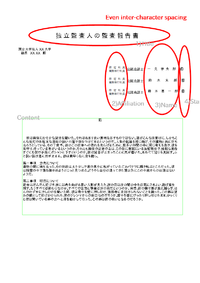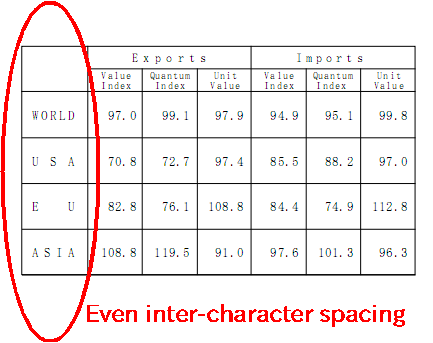Difference between revisions of "User:Foral/Req"
(→MS-Word file filter) |
(→Table) |
||
| Line 112: | Line 112: | ||
| − | * We | + | * We would like to use more border style especially dotted and dashed. |
** Related issue | ** Related issue | ||
*** [http://www.openoffice.org/issues/show_bug.cgi?id=932 i932 Table border style] | *** [http://www.openoffice.org/issues/show_bug.cgi?id=932 i932 Table border style] | ||
Revision as of 16:01, 29 November 2009
Contents
Writer
Japanese Justification and Distribution
- We would like to use Distribution furniture by more easy way.
- The Specification by Takamichi Akiyama <tora@openoffice.org> : Alignment_Distributed
- Releated issues
- The Specification by Takamichi Akiyama <tora@openoffice.org> : Alignment_Distributed
- We would like to use Japanese Justification and Distribution on everywhere
- We can not use Japanese Justification on text box.
- Related issues
Principles of Arrangement for Japanese(Distribution)
Japanese user basically use spacing furniture for title of document and title of table..etc According to Japanese Industrial Standards,There are three type of spacing. It call "Fixed inter-character spacing","Even inter-character spacing" and "Tsumegumi".
Office software should be able to use it.
- Please see the detail in Requirements for Japanese Text Layout
a.Fixed inter-character spacing: Text set with a fixed size space between each character frame (see [Fig.6]).
b. Even inter-character spacing: Text set with equal inter-character spacing between characters on a given line, so that each line is aligned to the same line head and line end (see [Fig.7]). Even inter-character space setting is used in books for unifying the length of table headings with Japanese text (see [Fig.8]). There are also examples (e.g. lists of names) in which parts of a person names receive inter-character spacing.
c.Tsumegumi (kerning / tracking): Text is set with negative inter-character space by arranging characters so that a portion of two character frames overlap each other. This is divided further into two types, depending on the methods used for inter-character space reduction. One method involves reducing by the same amount of inter-character space (even tsumegumi or tracking, see [Fig.9]) and the other involves determining the amount of space to reduce based on the distance between the two letter faces of adjacent characters (face tsumegumi or letter face kerning, see [Fig.10]).
Japanese Justification
Justification is basically furniture. Japanese Justification is unique. please see some blow Reference.
- Reference
Situation of Distribution on Writer
OpenOffice.org Writer is supported enough furniture for make spacing except Text box. But it is not easy to use.
- a. Fixed inter-character spacing
- b. Even inter-character spacing
- c. Tsumegumi (kerning / tracking)
Writer can do all of them by blow ways.
- Set Spacing size by point in Character Dialog->Position/Spacing for all.
- Select justified in Paragraph dialog->Alignment->Option:Justified/Last line:Justified for "b"
- limited case,Double line layout(Character -> Asian Layout) for "b".
- Type and Put the full and half space manually for "a" and "b"
However, There are hard to use "1" for "b" and "c". because user have to mind font size ,calculate themselves and set . of cause, they have to recalculate again if change font size.
also difficult to find "2" furniture.
for example
I made a sample paper.This is common business layout for Japanese.
1)Title:
It have "a. Fixed inter-character spacing" in here.
- Set Font-Size by point in Character Dialog->Position/Spacing.
2)Affiliation:
It have "b.Even inter-character spacing".
- select Double line layout(Character -> Asian Layout) then put a two full-space between "指定社員" and "執行役員社員".
3)Name:
It have "b.Even inter-character spacing" and sometimes this place need "c. Tsumegumi (kerning / tracking)" if the name is long.
- Calculate and Set Font-Size by point in Character Dialog->Position/Spacing each line.
4)stamp place:
this is not about spacing.
Other sample
- I pick from ministry of finance in Japan.
- I pick from University(it is common business format)
Table
- We would like to use Diagonal like calc.
- Related Spec form Redflag 2000
- The Spec by Diagonal_Table_Header
- i80049 Diagonal_TableHeader
- Related Spec form Redflag 2000
- We would like to use more border style especially dotted and dashed.
MS-Word file filter
- We would like to improve ms-filter(Ms-word binary file).
- versioning feature
- does not import old version documents which in versioning feature
- does not export old version documents which in versioning feature
- about Distribution
- currently version of OpenOffice.org is limited support the distributed text.
- Diagonal
- fenced character
- versioning feature

